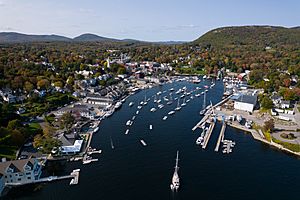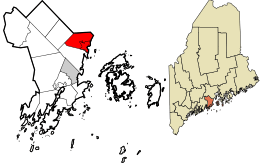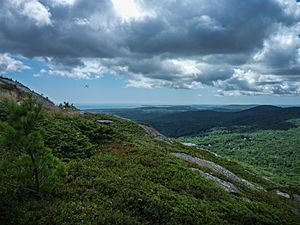Camden, Maine facts for kids
Quick facts for kids
Camden, Maine
|
|
|---|---|

Aerial view of Camden from the harbor
|
|

Location in Knox County and the state of Maine.
|
|
| Country | United States |
| State | Maine |
| County | Knox |
| Incorporated | 1791 |
| Villages | Camden Melvin Heights |
| Government | |
| • Type | Council–manager |
| Area | |
| • Total | 26.65 sq mi (69.02 km2) |
| • Land | 18.24 sq mi (47.24 km2) |
| • Water | 8.41 sq mi (21.78 km2) |
| Elevation | 207 ft (63 m) |
| Population
(2020)
|
|
| • Total | 5,232 |
| • Density | 287/sq mi (110.8/km2) |
| Time zone | UTC−5 (Eastern (EST)) |
| • Summer (DST) | UTC−4 (EDT) |
| ZIP Code |
04843
|
| Area code(s) | 207 |
| FIPS code | 23-09725 |
| GNIS feature ID | 0582384 |
Camden is a town in Knox County, Maine, in the United States. About 5,232 people lived there in 2020. Many more people visit or live there during the summer. It's a popular summer spot in Maine's Mid-Coast area. Like other famous places such as Bar Harbor, Camden is known for its summer visitors, often from big cities like Boston and New York City.
Contents
History of Camden
The Penobscot people lived in this area for thousands of years. They called it Megunticook. This name means "great swells of the sea." It describes the shape of the Camden Hills.
Europeans started settling here around 1771. This was after the French and Indian War. James Richards was one of the first settlers. He built a home by the Megunticook River. More people came, trying to farm the hilly land. An old house called the Conway House was built in 1770. Today, it is a history museum.
During the American Revolutionary War, the British held Castine, Maine. Camden became a meeting place for American soldiers. Major George Ulmer led these soldiers. The British once raided Camden and burned a sawmill.
On February 17, 1791, the area became a town. It was named Camden after Charles Pratt, a British politician. He supported civil liberties. During the War of 1812, a fort was built on Mount Battie. It had cannons, which helped keep the British away.
After the war, Camden grew quickly. The Megunticook River provided power for many mills. These mills made things like lumber, carriages, and paper. Shipyards also built many vessels. Camden was also known for making lime. This was a mineral dug from quarries.
In the 1880s, people started to discover Camden's natural beauty. They came for summer and autumn visits. Many wealthy families built large homes here. These homes were like the ones in Bar Harbor. People arrived by boat or train. Local people found jobs working for these new summer residents.
In 1892, a big fire burned down the business district. But Camden quickly rebuilt. They built new brick buildings, including the Camden Opera House. More wealthy people continued to come. In 1897, a road was built to the top of Mount Battie. An inn was also built there.
Wealthy families like the Curtis and Bok families gave money to the town. Their gifts helped build the Camden Public Library, the amphitheater, and the Camden Harbor Park.
Camden Yacht Club
Cyrus Curtis, a publishing leader, had a summer home in Camden. He also owned several yachts. In 1912, he decided to build the Camden Yacht Club. Yachting is still very popular in Camden today. Young sailors learn to race small boats. In 1936, the cruise schooner business started. These windjammer ships still sail today.
Music and Culture in Camden
Camden has a rich history of music and culture. In 1912, Edna St. Vincent Millay read her poem "Renascence" at the Whitehall Inn. She wrote the poem from the top of Mount Battie. Someone heard her and offered to pay for her to go to college. She later won a Pulitzer Prize for her poetry.
Carlos Salzedo, a famous harpist, started a harp colony in Camden. He held a Harp Festival each summer. Camden is also home to Bay Chamber Concerts. The Opera House hosts many theater shows.
In the 1950s, many artists and writers moved to Camden. Carousel was filmed here in 1956. Peyton Place was filmed in 1957. Camden's charming look made it a perfect setting for movies. Other films like Thinner and Casper were also filmed here. The TV show Passions used Camden for its outdoor scenes.
Camden hosts a summer Shakespeare festival. It takes place in an amphitheater behind the library. In February, the town holds the annual U.S. National Toboggan Championships. This race started as a fun winter activity. Now, it's a big event in New England. Teams race down a 400-foot (122 m) ice chute. They can reach speeds of up to 35 miles (56 km) per hour. Many racers wear costumes. Money from the race helps support the recreation area.
The Points North Institute is in Camden. It organizes the annual Camden International Film Festival (CIFF). This festival focuses on documentary films. It helps filmmakers connect and learn.
Geography of Camden
Camden covers about 26.65 square miles (69.02 km²). About 18.24 square miles (47.24 km²) is land. The rest is water. The Megunticook River flows through the town. Camden is located next to Penobscot Bay. This bay is part of the Atlantic Ocean.
Important bodies of water include Megunticook Lake and Hosmer Pond. Mount Megunticook is a tall peak in the area. It is 1,385 feet (419 m) high.
Major roads like U.S. Route 1 pass through Camden. The town shares borders with Rockport, Hope, and Lincolnville.
Climate in Camden
Camden has a humid continental climate. This means temperatures change a lot between seasons. Summers are warm, and winters are cold with snow.
| Climate data for W ROCKPORT 1 NNW, ME (1991–2020 normals) | |||||||||||||
|---|---|---|---|---|---|---|---|---|---|---|---|---|---|
| Month | Jan | Feb | Mar | Apr | May | Jun | Jul | Aug | Sep | Oct | Nov | Dec | Year |
| Mean daily maximum °F (°C) | 30.3 (−0.9) |
32.5 (0.3) |
39.6 (4.2) |
51.4 (10.8) |
62.4 (16.9) |
70.8 (21.6) |
76.7 (24.8) |
76.3 (24.6) |
69.0 (20.6) |
57.2 (14.0) |
46.7 (8.2) |
36.4 (2.4) |
54.1 (12.3) |
| Daily mean °F (°C) | 21.2 (−6.0) |
23.1 (−4.9) |
30.9 (−0.6) |
42.5 (5.8) |
53.3 (11.8) |
62.1 (16.7) |
68.2 (20.1) |
67.7 (19.8) |
60.5 (15.8) |
49.0 (9.4) |
38.9 (3.8) |
28.3 (−2.1) |
45.5 (7.5) |
| Mean daily minimum °F (°C) | 12.0 (−11.1) |
13.6 (−10.2) |
22.2 (−5.4) |
33.6 (0.9) |
44.1 (6.7) |
53.5 (11.9) |
59.6 (15.3) |
59.2 (15.1) |
51.9 (11.1) |
40.9 (4.9) |
31.1 (−0.5) |
20.2 (−6.6) |
36.8 (2.7) |
| Average precipitation inches (mm) | 4.75 (121) |
4.20 (107) |
5.01 (127) |
5.21 (132) |
4.22 (107) |
4.49 (114) |
3.20 (81) |
3.37 (86) |
4.49 (114) |
6.07 (154) |
5.27 (134) |
5.92 (150) |
56.20 (1,427) |
| Average snowfall inches (cm) | 17.2 (44) |
19.2 (49) |
11.3 (29) |
3.5 (8.9) |
0.0 (0.0) |
0.0 (0.0) |
0.0 (0.0) |
0.0 (0.0) |
0.0 (0.0) |
0.2 (0.51) |
2.3 (5.8) |
15.0 (38) |
68.7 (174) |
| Average precipitation days (≥ 0.01 in) | 9.8 | 8.8 | 9.8 | 10.8 | 11.8 | 11.7 | 10.5 | 9.3 | 8.9 | 11.0 | 9.7 | 11.9 | 124.0 |
| Average snowy days (≥ 0.1 in) | 5.5 | 5.7 | 3.5 | 1.1 | 0.0 | 0.0 | 0.0 | 0.0 | 0.0 | 0.1 | 0.7 | 4.2 | 20.8 |
| Source: NOAA | |||||||||||||
Population of Camden
| Historical population | |||
|---|---|---|---|
| Census | Pop. | %± | |
| 1790 | 331 | — | |
| 1800 | 872 | 163.4% | |
| 1810 | 1,607 | 84.3% | |
| 1820 | 1,825 | 13.6% | |
| 1830 | 2,200 | 20.5% | |
| 1840 | 3,005 | 36.6% | |
| 1850 | 4,005 | 33.3% | |
| 1860 | 4,588 | 14.6% | |
| 1870 | 4,512 | −1.7% | |
| 1880 | 4,386 | −2.8% | |
| 1890 | 4,621 | 5.4% | |
| 1900 | 2,825 | −38.9% | |
| 1910 | 3,015 | 6.7% | |
| 1920 | 3,403 | 12.9% | |
| 1930 | 3,606 | 6.0% | |
| 1940 | 3,554 | −1.4% | |
| 1950 | 3,670 | 3.3% | |
| 1960 | 3,988 | 8.7% | |
| 1970 | 4,115 | 3.2% | |
| 1980 | 4,584 | 11.4% | |
| 1990 | 5,060 | 10.4% | |
| 2000 | 5,254 | 3.8% | |
| 2010 | 4,850 | −7.7% | |
| 2020 | 5,232 | 7.9% | |
| U.S. Decennial Census | |||
In 2010, there were 4,850 people living in Camden. There were 2,382 households. About 21.4% of households had children under 18. Many households were made up of individuals. About 22.4% of people living alone were 65 or older.
The average age in Camden was 53.2 years. About 17.9% of residents were under 18. About 27.7% were 65 or older. More females lived in Camden than males.
Ancestry and Ethnicity
In 2017, the largest ancestry groups in Camden were:
| Largest ancestries (2017) | Percent |
|---|---|
| English | 28.1% |
| Irish | 19.7% |
| German | 14.1% |
| Scottish | 11.6% |
| Italian | 7.0% |
| French (except Basque) | 6.3% |
| French Canadian | 3.7% |
| Russian | 3.6% |
| Swedish | 3.4% |
| Dutch | 3.3% |
| Welsh | 2.7% |
| Portuguese | 2.3% |
Education in Camden
Camden has several schools for students. These include public and private options.
- The Children's House Montessori School
- Ashwood Waldorf School
- People Place Cooperative Preschool
- Schools run by MSAD 28:
- Camden Rockport Elementary School
- Camden Rockport Middle School
- Schools run by the Five Town Community School District:
- Camden Hills Regional High School
- The Watershed School
Places to Visit in Camden
- Bald Mountain
- Bay Chamber Concerts
- Camden Public Library
- The Walsh History Center
- Camden Hills State Park
- Camden Opera House
- Camden Snow Bowl
- Curtis Island Lighthouse
- Maiden's Cliff
Notable People from Camden
Many interesting people have lived in Camden, including:
- Gordon Bok, a singer and songwriter
- Cyrus Curtis, a publishing leader
- Paul Doiron, a novelist
- Tess Gerritsen, a novelist
- David McCullough, a historian and author
- Don McLean, a singer and songwriter
- Edna St. Vincent Millay, a famous poet
- Richard Russo, a novelist
- John Sculley, a former CEO of Apple
- Thomas J. Watson, who founded IBM
Images for kids
See also
 In Spanish: Camden (Maine) para niños
In Spanish: Camden (Maine) para niños












